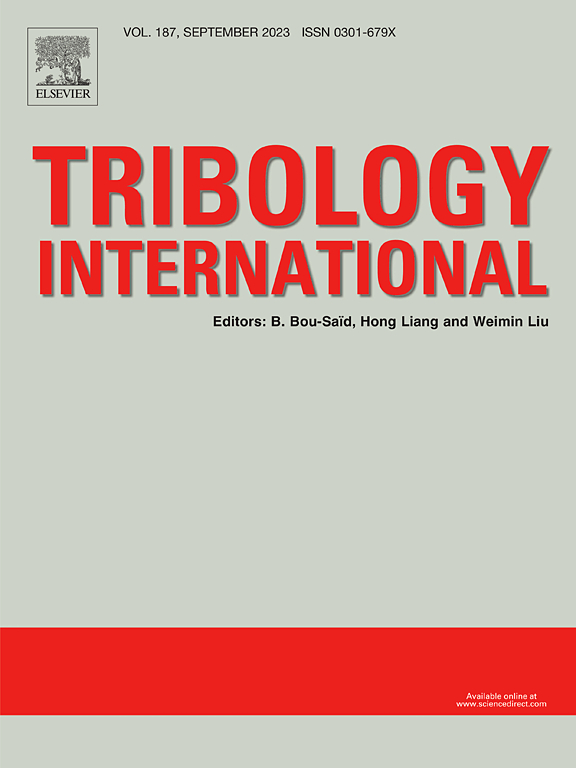超高分散MoS2QDs杂化聚乙二醇:多层异质结构摩擦膜
IF 6.1
1区 工程技术
Q1 ENGINEERING, MECHANICAL
引用次数: 0
摘要
采用水热法制备了尺寸为4 ~ 7 nm的二硫化钼量子点(MoS2QDs)。合成的MoS2QDs在peg200中具有超高的色散稳定性(100天)。在基础油中加入0.08 wt%的MoS2QDs,在摩擦学测试中获得86.8% %的磨损减少。润滑机制涉及三个协同过程:(a) MoS2QDs填充和修复磨损表面。(b)循环载荷诱导界面铁纳米晶的生成。MoS2QDs和铁纳米晶粘附或嵌入磨损碎屑中,形成多层非均质结构。(c)二硫化钼量子点、铁纳米晶体和多层非均质结构的结合,形成了具有润滑和承载性能的原位摩擦膜。多层异质结构磨损碎片的发现为量子点的润滑机制提供了新的见解。本文章由计算机程序翻译,如有差异,请以英文原文为准。
Ultra-high dispersion MoS2QDs hybrid polyethylene glycol: Multilayer heterostructure tribofilm
Molybdenum disulfide quantum dots (MoS2QDs) with controlled sizes (4–7 nm) were synthesized via a hydrothermal method. The synthesized MoS2QDs exhibited ultra-high dispersion stability in PEG 200 (>100 days). Adding 0.08 wt% MoS2QDs to base oil achieved 86.8 % wear reduction in tribological tests. The lubrication mechanism involves three synergistic processes: (a) MoS2QDs fill and repair worn surfaces. (b) Cyclic loads induce the generation of interfacial iron nanocrystals. MoS2QDs and iron nanocrystals adhere to or embed into wear debris, forming a multilayered heterogeneous structure. (c) The combination of MoS2QDs, iron nanocrystals, and the multilayered heterogeneous structure creates an in-situ tribofilm with lubricating and load-bearing properties. The discovery of multi-layer heterostructure wear debris provides new insights into the lubrication mechanisms of quantum dots.
求助全文
通过发布文献求助,成功后即可免费获取论文全文。
去求助
来源期刊

Tribology International
工程技术-工程:机械
CiteScore
10.10
自引率
16.10%
发文量
627
审稿时长
35 days
期刊介绍:
Tribology is the science of rubbing surfaces and contributes to every facet of our everyday life, from live cell friction to engine lubrication and seismology. As such tribology is truly multidisciplinary and this extraordinary breadth of scientific interest is reflected in the scope of Tribology International.
Tribology International seeks to publish original research papers of the highest scientific quality to provide an archival resource for scientists from all backgrounds. Written contributions are invited reporting experimental and modelling studies both in established areas of tribology and emerging fields. Scientific topics include the physics or chemistry of tribo-surfaces, bio-tribology, surface engineering and materials, contact mechanics, nano-tribology, lubricants and hydrodynamic lubrication.
 求助内容:
求助内容: 应助结果提醒方式:
应助结果提醒方式:


